Chapter: Problem Solving and Python Programming : Control Flow, Functions
Iteration/Control Statements - Python
ITERATION/CONTROL
STATEMENTS:
·
state
·
while
·
for
·
break
·
continue
·
pass
State:
Transition from
one process to another process under specified condition with in a time is
called state.
While loop:
·
While loop
statement in Python is used to repeatedly executes set of statement as long as
a given condition is true.
· In while loop, test expression is checked first. The body of the loop is entered only if the test_expression is True. After one iteration, the test expression is checked again. This process continues until the test_expression evaluates to False.
·
In
Python, the body of the while loop is determined through indentation.
·
The
statements inside the while starts with indentation and the first unindented
line marks the end.
Syntax:
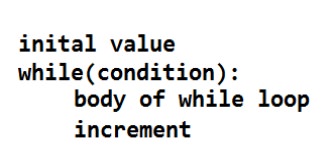
Flowchart
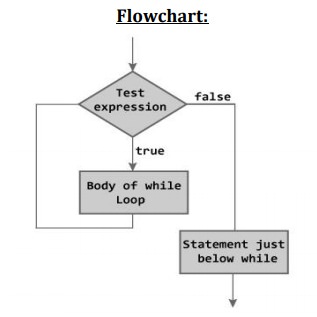
Examples:
1.
program to find
sum of n numbers:
2.
program to find
factorial of a number
3.
program to find
sum of digits of a number:
4.
Program to
Reverse the given number:
5.
Program to find
number is Armstrong number or not
6.
Program to check
the number is palindrome or not
Sum of n numbers:
n=eval(input("enter
n"))
i=1
sum=0
while(i<=n):
sum=sum+i
i=i+1
print(sum)
output
enter n
10
55
Factorial of a numbers:
n=eval(input("enter
n"))
i=1
fact=1
while(i<=n):
fact=fact*i
i=i+1
print(fact)
output
enter n
5
120
Sum of digits of a number:
n=eval(input("enter
a number"))
sum=0
while(n>0):
a=n%10
sum=sum+a
n=n//10
print(sum)
output
enter a number
123
6
Reverse the given number:
n=eval(input("enter
a number"))
sum=0
while(n>0):
a=n%10
sum=sum*10+a
n=n//10
print(sum)
output
enter a number
123
321
Armstrong number or not
n=eval(input("enter
a number"))
org=n
sum=0
while(n>0):
a=n%10
sum=sum+a*a*a
n=n//10
if(sum==org):
print("The
given number is Armstrong number")
else:
print("The
given number is not
Armstrong
number")
output
enter a
number153
The given number
is Armstrong number
Palindrome or not
n=eval(input("enter
a number"))
org=n
sum=0
while(n>0):
a=n%10
sum=sum*10+a
n=n//10
if(sum==org):
print("The
given no is palindrome")
else:
print("The
given no is not palindrome")
output
enter a
number121
The given no is
palindrome
For loop:
for in range:
v
We can generate a sequence of numbers using range() function.
range(10) will generate numbers from 0 to 9 (10 numbers).
v
In range function have to define the start, stop and step size as range(start,stop,step size).
step size defaults to 1 if not provided.
Syntax

Flowchart:
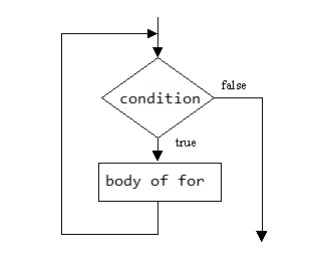
For in sequence
The for loop in Python is used to iterate over a sequence (list, tuple, string). Iterating over a sequence is called traversal. Loop
continues until we reach the last element in the sequence.
The body of for loop is separated from the rest of the code
using indentation.

Sequence can be a list, strings or tuples
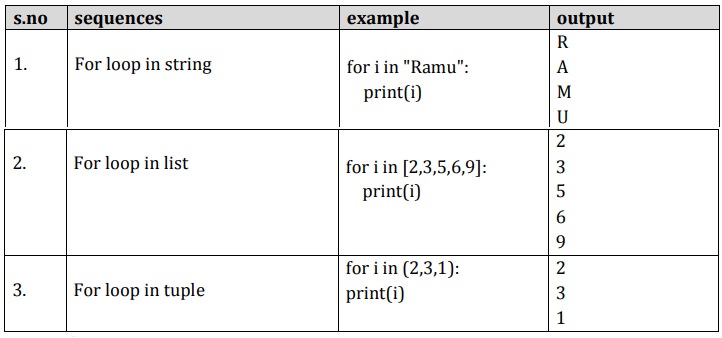
Examples:
1.
print
nos divisible by 5 not by 10:
2.
Program
to print fibonacci series.
3.
Program
to find factors of a given number
4.
check
the given number is perfect number or not
5.
check
the no is prime or not
6.
Print
first n prime numbers
7.
Program
to print prime numbers in range
print nos divisible by 5 not by 10
n=eval(input("enter
a"))
for i in
range(1,n,1):
if(i%5==0
and i%10!=0):
print(i)
output
enter
a:30
5
15
25
Fibonacci series
a=0
b=1
n=eval(input("Enter
the number of terms: "))
print("Fibonacci
Series: ")
print(a,b)
for i in
range(1,n,1):
c=a+b
print(c)
a=b
b=c
output
Enter
the number of terms: 6
Fibonacci
Series:
0 1
1
2
3
5
8
find factors of a number
n=eval(input("enter
a number:"))
for i in
range(1,n+1,1):
if(n%i==0):
print(i)
Output
enter a
number:10
1
2
5
10
check the no is prime or not
n=eval(input("enter
a number"))
for i in
range(2,n):
if(n%i==0):
print("The
num is not a prime")
break
else:
print("The
num is a prime number.")
output
enter a
no:7
The num
is a prime number.
check a number is perfect number or not
n=eval(input("enter
a number:"))
sum=0
for i in
range(1,n,1):
if(n%i==0):
sum=sum+i
if(sum==n):
print("the
number is perfect number")
else:
print("the
number is not perfect number")
Output
enter a
number:6
the
number is perfect number
Program to print first n prime numbers
number=int(input("enter no
of prime
numbers
to be displayed:"))
count=1
n=2
while(count<=number):
for i in
range(2,n):
if(n%i==0):
break
else:
print(n)
count=count+1
n=n+1
Output
enter no
of prime numbers
to be
displayed:5
2
3
5
7
11
Program to print prime numbers in range
lower=eval(input("enter
a lower range"))
upper=eval(input("enter
a upper range"))
for n in
range(lower,upper + 1):
if n
> 1:
for i in
range(2,n):
if (n %
i) == 0:
break
else:
print(n)
output:
enter a
lower range50
enter a
upper range100
53
59
61
67
71
73
79
83
89
97
Loop Control Structures
BREAK
v Break statements can alter the
flow of a loop.
v It terminates the current
v loop and executes the remaining statement
outside the loop.
v If the loop has else statement, that will also
gets terminated and come out of the loop completely.
Syntax:
Break
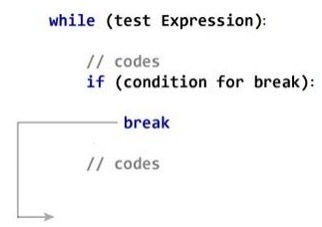
Flowchart
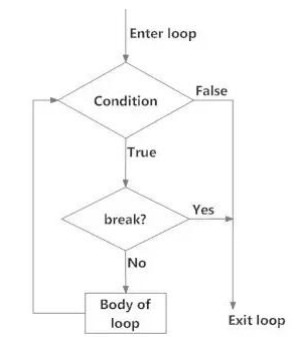
example
for i in
"welcome":
if(i=="c"):
break
print(i)
Output
w
e
l
CONTINUE
It terminates
the current iteration and transfer the control to the next iteration in the
loop.
Syntax:
Continue
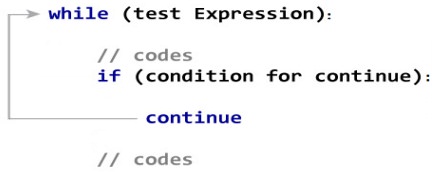
Flowchart
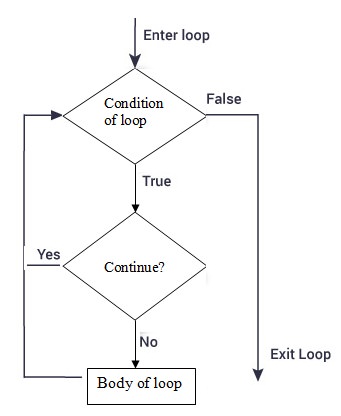
Example:
for i in
"welcome":
if(i=="c"):
continue
print(i)
Output
w
e
l
o
m
e
PASS
v It is used when a statement is required
syntactically but you don’t want any code to execute.
v It is a null statement, nothing happens when
it is executed.
Syntax:
pass
break
Example
for i in
“welcome”:
if (i == “c”):
pass
print(i)
Output
w
e
l
c
o
m
e
Difference between break and continue
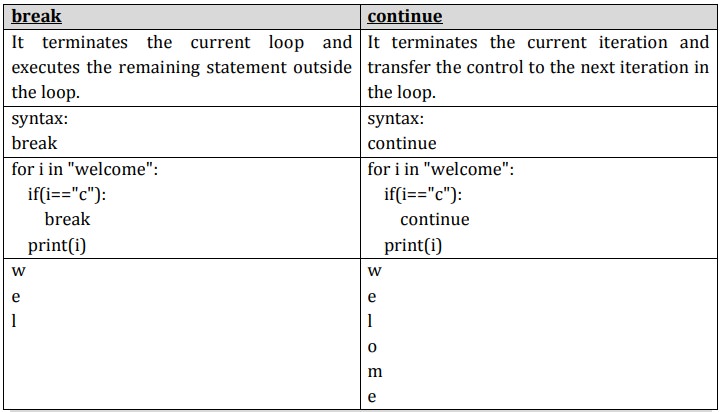
else statement in loops:
else in for loop:
v If else statement is used in for loop, the
else statement is executed when the loop has reached the limit.
v The statements inside for loop and statements
inside else will also execute.
example
for i in
range(1,6):
print(i)
else:
print("the
number greater than 6")
output
1
2
3
4
5 the number greater than 6
else in while loop:
v If else statement is used within while loop ,
the else part will be executed when the condition become false.
v The statements inside for loop and statements
inside else will also execute.
Program
i=1
while(i<=5):
print(i)
i=i+1
else:
print("the
number greater than 5")
output
1
2
3
4
5
the number
greater than 5
Related Topics